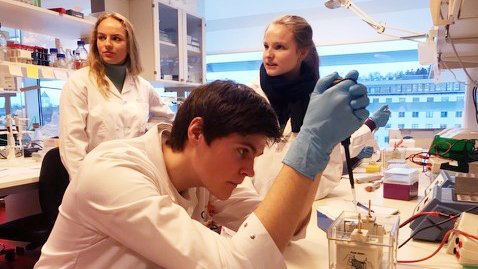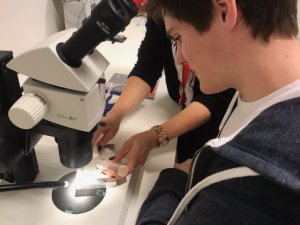Operation fruit flies

Fruit flies are not only annoying little insects that appear when bananas are overripe. They are also popular research tools for cancer researchers.
The four pupils Kalina Topalova Casadiego, Ida Hustad Andresen, Andreas Bernhus and Dina Düring got to experience how cancer researchers look at fruit flies during their work placement in January.
“Let’s turn on the gas, and then I’ll put some fruit flies on the pad under your microscope.” Speaking is cancer researcher Lene Malrød who, together with her colleague Nina Marie Pedersen, is responsible for four pupils from Ullern Secondary School on work placements.
“Gosh! They’re moving,” proclaims one of the pupils.
But not for long. Soon, all the fruit flies are anaesthetised and, eventually, dead; then the pupils are tasked with surgically removing the ovaries of the female flies. It is easier said than done, even with the help of microscopes to enhance the tiny flies. Especially when the operating tools are two tweezers.
An exciting placement
It is the third day of the pupils’ work placement at the Institute for Cancer Research, located next to the school. For four days at the end of January, they have learnt about cancer research and which methods researchers use in their daily work.
“The work placement is not like we imagined,” says Kalina and Ida.
“There’s a lot more manual work than I would have thought, and then you realise how important research is through what we do,” says Ida.
She is the only one who is specialising in biology in combination with with other science subjects, and she finds this very useful when working in the lab together with researchers. The other three have had to catch up on the reading, but they all agree that it is very exciting.
“Yesterday, we learnt a lot about CRISPR, which is a new method for cutting and splicing genes. Media gives you the impression that this is a highly precise tool, but the researchers here say that a lot can go wrong, and that it’s not at all as precise as you might think,” says Ida.
From Western Blot to flies
A total of twelve pupils were picked out for this work placement. They have been chosen based on motivation and grades, and they all have a wish to study something related to medicine or science after they finish upper secondary school.
The twelve students are divided into three groups with completely different activities and get to learn a number of different research methods. The group consisting of Ida, Kalina, Andreas, and Dina, for instance, is the only group which will have a go in the fly lab.
“Am I really supposed to remove the ovaries? I don’t see how,” one of the pupils say, equally discouraged and excited.
Andreas, on the other hand, is in complete control. First, he has separated the males and the females with a paint brush. He has then used the tweezers to remove the heads from the females, punctured the bottom to remove the intestines, and finally found the ovaries in the abdomen.
Lene gathers all the different body parts for the pupils to look at through a different microscope. These fruit flies are in fact genetically manipulated to glow in the dark – they are fluorescent.
If you are wondering why researchers use fruit flies as part of their research, you can read more about it in this article from Forskning.no (the article is written in Norwegian).
“It is so much fun to be here, and we are really lucky to get this opportunity,” says Dina on her way from the fly lab to another lab to carry out another experiment.
The pupils on the work placement have uploaded many nice photos and videos on Ullern Secondary School’s Instagram account – visit their account to see more from the placement.

 OCC
OCC

 OCC
OCC